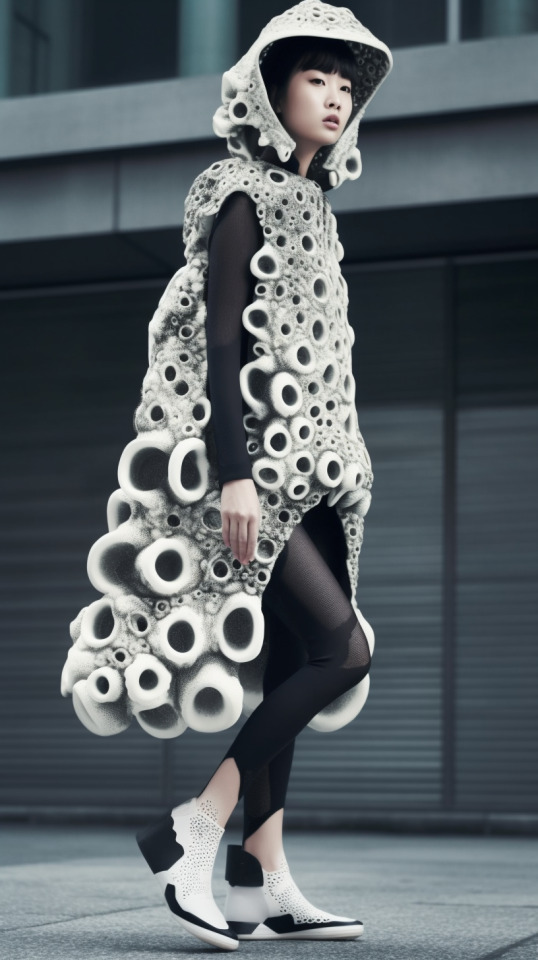#fashionai
Text

Naomi. Midjourney
14 notes
·
View notes
Text

Thank you to everyone who got me to 50 likes!
#50 likes#tumblr milestone#thank you#fashionai#ootd#outfitideas#fashionableai#styleinspiration#fashiontrends#fashionista#aistylist#fashioninnovation#fashionforward#munshsstore#munchsstore#teespring#spring#etsy
2 notes
·
View notes
Text










3 notes
·
View notes
Link
#ai#AIstyle#fashionAI#AIwardrobe#smartfashion#aibikinibeach#AIclothing#virtualfashion#futurefashion#AIoutfit#machinelearningfashion#BIKINI#lookbook#룩북#AI룩북#AIスタイル#流行人工知能#AIワードローブ#スマートファッション#テックスタイル#AI服#バーチャルファッション#未来のファッション#AI装備#機械学習ファッション#ビキニ#ルックブック#AI風格#時尚人工智能#A衣櫃
2 notes
·
View notes
Text
The Role of Product Tagging in Ecommerce

In the dynamic landscape of ecommerce, where millions of products vie for consumer attention, effective product tagging has emerged as a crucial tool for success. As online shopping continues to reshape retail, businesses are seeking innovative ways to enhance customer experiences, streamline search processes, and drive sales. Among these strategies, product tagging stands out as a key element that bridges the gap between products and consumers. This article explores the significance of product tagging in ecommerce and how it contributes to the triumph of online businesses.
The Power of Product Tagging
Product tagging involves assigning descriptive keywords, labels, or categories to products in order to facilitate easier navigation and discovery. These tags serve as the bridge that connects customers' search intent with the relevant products in an online store. When implemented thoughtfully, product tagging offers a plethora of benefits:
Enhanced Search and Navigation: In a virtual marketplace where customers can't physically interact with products, effective tagging empowers them to find what they need swiftly. Tags enable intuitive searches, aiding customers in locating products based on color, size, brand, and other attributes.
Personalized Shopping Experience: By understanding customer preferences through their interactions with tagged products, ecommerce platforms can deliver personalized recommendations. This enhances customer satisfaction and increases the likelihood of conversions.
Improved SEO: Product tags play a crucial role in search engine optimization (SEO). When customers search for specific terms, products with well-tagged descriptions are more likely to appear in search results, increasing visibility and driving organic traffic.
Efficient Inventory Management: Internal tagging systems benefit businesses by facilitating streamlined inventory management. Tags can be used to categorize products based on their availability, popularity, or seasonality, helping businesses make informed decisions.
Cross-Selling and Upselling: Product tags also enable cross-selling and upselling opportunities. When a customer views a particular product, related items with matching tags can be suggested, increasing the chances of multiple purchases.
Targeted Marketing Campaigns: Precisely tagged products allow businesses to run targeted marketing campaigns. These campaigns can focus on specific customer segments, leveraging the tags associated with the products customers have previously shown interest in.
Optimized User Interface: Well-implemented product tagging contributes to an intuitive user interface, making the shopping experience smoother and more enjoyable. It minimizes frustration and encourages customers to explore more products.
Challenges for Effective Product Tagging and Strategies
While effective product tagging offers numerous benefits to ecommerce businesses, it also comes with its fair share of challenges. Overcoming these challenges is essential to ensure that product tagging truly enhances the customer experience and contributes to the success of an online store. Here are some common challenges for effective product tagging.
Tagging Consistency and Accuracy: Maintaining consistent and accurate tagging across a large inventory can be challenging. Different team members might interpret tags differently, leading to inconsistencies in categorization and search results. Additionally, inaccurately tagged products can result in frustrated customers who can't find what they're looking for.
Choosing Relevant Tags: Selecting the most relevant and effective tags for each product can be a complex task. Poorly chosen tags can lead to products not appearing in relevant search results or appearing in irrelevant ones.
Managing Diverse Products: Ecommerce platforms often offer a wide variety of products, each with its own set of attributes and characteristics. Categorizing and tagging such diverse items accurately can be overwhelming.
Seasonal and Trend-based Challenges: Products and their attributes can change with seasons and trends, requiring constant updating of tags. Failing to adapt to these changes can result in products being misplaced or overlooked by customers.
Balancing Automation and Human Touch: While automation can streamline the tagging process, it might not always capture the nuances of products accurately. Overreliance on automation can result in generic or incorrect tags.
Tagging Multilingual Products: If your ecommerce store operates in multiple languages, translating and tagging products accurately across different languages can be a challenge.
Evolving Customer Preferences: Customer preferences and search behaviors can evolve over time. What might have been an effective tag yesterday may not be relevant today.
Best Practices for Effective Product Tagging
To leverage the power of product tagging, ecommerce businesses should adhere to certain best practices:
Choose Relevant Tags: Select tags that accurately represent the product's attributes, usage, and purpose. Avoid overloading products with irrelevant tags, as this can confuse customers and negatively impact search algorithms.
Prioritize Consistency: Maintain consistency in tag usage to ensure that similar products are categorized uniformly. This consistency aids both customers and search engines in understanding the products
Utilize Hierarchy: Employ a hierarchical tagging structure to group products in meaningful categories. This assists in navigating through a diverse range of products efficiently.
Stay Updated: Regularly review and update product tags to reflect changing trends, seasons, and customer preferences. Outdated tags can hinder search results and lead to frustration.
Monitor Analytics: Keep track of how customers interact with tagged products. Analyze which tags lead to higher engagement and conversions, and adjust your tagging strategy accordingly.
Conclusion
In the competitive realm of ecommerce, where the success of businesses hinges on providing exceptional customer experiences, product tagging emerges as a powerful ally. This seemingly simple practice significantly contributes to enhancing search functionality, personalization, and overall user satisfaction. By implementing effective product tagging strategies, ecommerce businesses can triumph over challenges, drive sales, and create lasting customer relationships in the digital marketplace. As technology continues to evolve, the role of product tagging will only become more crucial in shaping the future of ecommerce.
1 note
·
View note
Text

ai fashions, ai fashion, fashionwithkorea.com,
https://www.fashionwithkorea.com
#ai fashion#fashionwithkorea.com#aifashion#aifashions#aifashionshop#aifashionstore#shopaifashion#artificialintelligencefashion#artificialfashion#intelligencefashion#aifashionnft#fashionintelligence#nftaifashion#fashionartificial#fashionai#fashionsai#aifashionist#fashionistai#aifashionista#时尚达人人工智能#时尚人工智能#人工智能时尚达人#人工智能时尚#ai fashions#ai fashionist#fashion ai#fashions ai
1 note
·
View note
Photo

With determination and perseverance, you can overcome any obstacle and achieve success. Model : ai Prompt: Sony A7IV, Zeiss 35mm . . . . #fashionAI #photographyAI #AIstyle #AIphotography #FashionAndAI #isitreal #midjourney (at Midjourney) https://www.instagram.com/p/Cm99C-UOpFv/?igshid=NGJjMDIxMWI=
1 note
·
View note
Photo

My other attempt at AI art, I'm actually a painter, so I have a deep seated love for the genre... this was done with midjoourney I'm addicted. It's going to put us out of work...LOL #aiart #midjourneyart #lensaapp #blackart #fashionartwork #fashionai #aifashiondesign #digitalartist (at New York, New York) https://www.instagram.com/p/Cm7KqaIuVt_/?igshid=NGJjMDIxMWI=
0 notes
Photo

Zarathustra Women XLI #Art #aiart #dream #anime #animationart #artai #ai #fashion #aifashion #fashionstyle #future #futurestic #futurefashion #fashionai #aifashion #aiartcommunity #aiartwork #aiartsociety #aiartists #aiartdailytheme #aiartgenerator #aiarts #aiartchallenge #aiartoftheday #aiartpioneer #aiartits #aiartapp #aiartshow #aiartvideo #aiartistry #aiartistoninstagram https://www.instagram.com/p/CmrrPoTOjXm/?igshid=NGJjMDIxMWI=
#art#aiart#dream#anime#animationart#artai#ai#fashion#aifashion#fashionstyle#future#futurestic#futurefashion#fashionai#aiartcommunity#aiartwork#aiartsociety#aiartists#aiartdailytheme#aiartgenerator#aiarts#aiartchallenge#aiartoftheday#aiartpioneer#aiartits#aiartapp#aiartshow#aiartvideo#aiartistry#aiartistoninstagram
0 notes
Text

CRAMP/CRUMP - Here is the fruit of a long, already finished some time ago, work. A clip created using, of course, artificial intelligence. Now it's time for the next one.
#artcommunity#ai#promptart#promptdesign#DALLE#aidesign#midjourney#midjourneyart#design#colors#kidsdesign#minimalistcolor#colordesign#fun#fashiondesign#sneakersdesign#fashionart#fashionaie
1 note
·
View note
Text

@rubiesintherough asked: “ warriors are not born they are made, and so are broken souls ” ( bren? tentatively offers my dragon boy for a medieval au? )
[ poetry prompts ]
“Some might disagree with you on that one. My own family, for starters. Those of us who were broken into this life and raised to fight would sooner kill a man for suggesting they were merely made men and women rather than born into the cause. When you’re dealing with legacy and magic as old as the kind that flows through our veins, to insult one’s proclaimed birthright is worse than insulting their mother.”

0 notes
Text





Midjourney (Artificial) Blues
#brazil#brasil#aistreetphotography#midjourney#aiart#midjorneyart#ai photography#balenciaga#aifashion#fashionai
6 notes
·
View notes
Text
#FashionAI#StyleInspiration#OutfitIdeas#FashionableAI#AIStylist#FashionTrends#FashionAdvice#StyleTips#FashionInnovation#VirtualStylist#AIFashion#Fashionista#OOTD#FashionGoals#FashionForward#TrendyLooks#FashionInfluencer#FashionInspo#StyleOfTheDay#ViralFashion#FashionableOutfits#AIStyle#FashionLovers#FashionCommunity#FashionCreators#FashionableAIAssistant#FashionSolutions#AIFashionTips#FashionOnDemand#FashionRevolution
1 note
·
View note
Text



#ai #aiart #aiartwork #generativeart #aidesign #digitalart #conceptart #pixelart #artificialintelligence #midjourney #fashionista #styleinspiration #romanticstyle #chiffondress #AIinFashion #fashionAI #AIstyle #fashiontech #futureoffashion #fashiondesign #designerstyle #luxuryfashion
3 notes
·
View notes
Text
Good friction -GUESS uses Fashion AI Technology to Boost its Sales.
GUESS leverages AI technology through its partnership with Alibaba Group, utilizing Alibaba's FashionAI system to enhance customer experience in its concept stores. This system integrates smart racks, smart mirrors, and next-generation fitting rooms to provide personalized clothing and accessory recommendations from both the GUESS line and other sellers on Tmall and Taobao, China's leading B2C and C2C platforms. Over five years of collaboration have positioned GUESS as a top brand on Tmall, achieving over 100% compounded growth in three years. The incorporation of O2O New Retail concepts, facilitated by advancements in AI, has significantly boosted GUESS's performance in the Asia Pacific region. Looking forward, GUESS aims to expand this AI-enhanced retail experience globally, furthering its commitment to innovative customer service and strategic growth.
The integration of Alibaba's FashionAI technology is the "good friction" for GUESS, which enhances the customer shopping experience by introducing interactive and intelligent elements that actively engage customers and assist them in making informed purchasing decisions

1 note
·
View note









